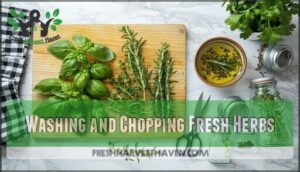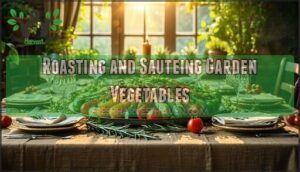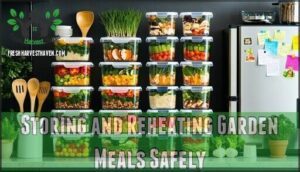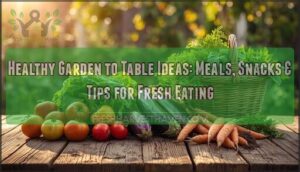This site is supported by our readers. We may earn a commission, at no cost to you, if you purchase through links.
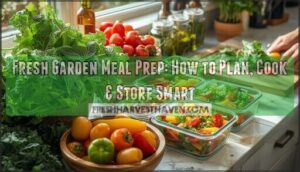
Fresh garden meal prep isn’t just about eating healthier; it’s about respecting the work you put into growing your own food and actually using it before it goes bad. When you harvest leafy greens and eat them within hours, they pack 25% more antioxidants than anything you’ll find at the grocery store.
But here’s the catch: without a solid prep system, those nutrient-dense treasures turn into mush faster than you can say "sustainable living." The solution? Smart planning, efficient cooking techniques, and storage methods that keep your garden haul fresh and ready to eat all week long.
Table Of Contents
Key Takeaways
- Fresh-picked garden produce contains up to 50% more vitamin C and 25% more antioxidants than store-bought options, but you’ll need a solid prep system to capture those nutrients before everything wilts.
- Strategic meal prep with your garden harvest can slash grocery bills by $600 to $2,300 annually while cutting food waste—that $15 worth of forgotten kale adds up fast.
- Success comes down to three moves: eating what’s in season for peak nutrition and lower costs, batch-prepping on Sunday to control your week, and storing everything properly so meals stay fresh for 3-4 days.
- Hardy vegetables like carrots, beets, and kale prep beautifully in advance when stored in airtight containers, while delicate herbs should be added right before serving to preserve their flavor.
Fresh Garden Meal Prep Basics
Fresh garden meal prep isn’t just about eating healthier—it’s about taking back control of your plate while saving time and money.
Before you start tossing ingredients into containers, you need to understand what makes garden-fresh meals worth the effort, which ingredients deserve a permanent spot in your rotation, and how to pick the right containers that actually keep your food fresh.
Here are three essentials you’ll want to nail down first.
Benefits of Fresh Garden Meals
Think of fresh garden meals as your nutrition insurance policy. You’ll get up to 50% more vitamin C when you eat vegetables straight from the garden—no transit time means nutrients stay locked in. Here’s what garden-to-table cooking brings to your plate:
- Nutrition Boost: Leafy greens contain 25% more antioxidants when harvested and eaten within hours
- Environmental Impact: Homegrown tomatoes cut CO₂ emissions by nearly 40% compared to store-bought
- Healthy Eating: Gardeners increase veggie intake by 0.63 servings daily—that’s sustainable living in action
- Financial Freedom: Save $92 monthly while enjoying fresh food systems you control
- Mental Wellness: Garden meals reduce depression and anxiety while building community
Fresh Kitchen knows what registered dietitians have proven: sustainable eating starts with healthy meal ideas you can actually stick with. By adopting a homegrown food approach, individuals can experience numerous benefits that extend beyond nutrition to environmental and financial advantages.
Essential Garden Ingredients
Your best meal prep starts with knowing which garden ingredients actually make it through the week without turning to mush in your fridge. Focus on hardy fresh greens like kale and cabbage—they’ll last 5-7 days. Garden herbs stay vibrant when stored stem-down in water. Microgreens add nutrition without wilting fast.
Seasonal produce and organic fruits keep longer when picked at peak ripeness. Master vegetable gardening basics and you’ll discover garden-to-table cooking that transforms garden-fresh vegetable recipes into sustainable meals all week long.
Choosing Meal Prep Containers
The wrong container turns your perfectly prepped garden meals into a soggy disaster by Wednesday, so let’s pick ones that actually work. Here’s what you need for meal planning success:
- Glass containers with airtight lids keep food fresh longer and won’t stain
- BPA-free plastic works great for portability and meal prep tips on the go
- Multiple container sizes let you customize portions like made-to-order food
- Separate compartment trays prevent soggy greens when storing dressings
- Stackable designs optimize fridge space during weekly food storage prep
Planning Your Garden-Inspired Meals
Garden meal planning doesn’t need to be complicated. Focus on what’s ready to harvest and create a loose weekly system that cuts down on grocery bills and last-minute dinner stress.
Your garden harvest can do more than just sit in a basket—let’s put it to work.
Here’s how to make your garden harvest work harder for you.
Eating What’s in Season
Seasonal eating makes practical sense for your budget, nutrition, and environmental impact. Fresh produce in season delivers up to 50% more vitamin C and costs 30-55% less than imported alternatives.
Choosing what’s locally available turns your meal planning into active participation in sustainable food systems.
Eating seasonally isn’t just trendy—it’s a smart move for your wallet, your health, and the planet. In-season produce packs up to 50% more vitamin C and costs 30-50% less than out-of-season options. When you align your meal prep with what’s fresh and local, you’re building sustainable food systems right from your own kitchen.
Here’s your seasonal produce roadmap:
| Season | Star Picks | Why They Rock |
|---|---|---|
| Spring | Asparagus, peas, strawberries | Peak nutrient density, naturally sweet |
| Summer | Tomatoes, zucchini, peppers | Loaded with antioxidants, incredibly flavorful |
| Fall | Squash, apples, kale | Hearty, stores well, perfect for batch cooking |
| Winter | Root vegetables, citrus, cabbage | Budget-friendly, immune-supporting vitamins |
| Year-round | Local greens, herbs, sprouts | Farm-to-table freshness, minimal carbon footprint |
By choosing seasonal food options, individuals can markedly reduce their environmental impact while enjoying fresher and more nutritious meals. Local sourcing through farmers’ markets or your own garden means you’re getting fresh harvest at its absolute best—more vitamins, better taste, and you’re supporting sustainable eating practices that matter.
That’s the real deal behind gardening and food: seasonal meal planning that actually works for your life and your values.
Creating a Weekly Meal Prep Schedule
Once you’ve got your seasonal produce lined up, carving out two hours on a Sunday afternoon can transform your entire week from chaotic to controlled. Use meal planning tools to sketch a simple weekly schedule—batch-cook grains, roast veggies, prep proteins.
Write grocery lists based on garden harvests and farmers’ market finds. This garden to table cooking approach turns homestead cooking into efficient meal prep that actually sticks.
Budgeting and Saving With Garden Produce
Your garden can slash grocery bills by hundreds—or even thousands—of dollars each year. Families growing their own produce report saving $600 to $2,300 annually through smart harvest optimization and budget planning. Track what you grow against store prices to see real garden cost savings.
Focus on high-yield crops like tomatoes and lettuce for maximum produce yield. With seasonal discounts at farmers’ markets and your own garden-to-table cooking, meal planning becomes both cheaper and fresher—true homesteading magic that promotes organic gardening and farm-to-table living.
Efficiently Preparing Garden Ingredients
Here’s what you need to know about prepping herbs, vegetables, and proteins so they’re grab-and-go ready.
Here’s how to manage herbs, vegetables, and proteins so they’re ready when you’re.
Washing and Chopping Fresh Herbs
Fresh herbs straight from the garden deserve a little TLC before they hit your meal prep containers—and trust me, a quick rinse and chop now will save you serious time later in the week.
Start with herb cleaning: swirl them gently in cold water to remove dirt and critters. Pat dry with paper towels or use a salad spinner.
For herb chopping tips, stack leaves and slice with a sharp knife—bruising releases those aromatic herb uses you want preserved.
Fresh herb storage works best wrapped in damp towels inside sealed containers.
Roasting and Sauteing Garden Vegetables
When you roast or sauté your garden veggies, you’re not just cooking—you’re unlocking flavor bombs that make meal prep something you’ll actually look forward to eating. Here’s how to nail seasonal cooking with fresh vegetable recipes:
- Roasted roots like carrots and beets caramelize beautifully at 425°F—toss with herb infusions before baking
- Sautéed greens (kale, chard) need just garlic and a splash of ume plum vinegar
- Vegetable blends work great for roasted vegetable recipes—mix what’s ripe now
- Garden skewers turn grilled vegetable recipes into easy grab-and-go options
Cooking and Grilling Healthy Proteins
Your garden veggies need a protein match that’s equally fresh and flavorful. The cooking method you choose determines whether you end up with dry, bland meat or juicy, meal-prep-ready results.
Your garden veggies deserve a protein partner that’s just as fresh and flavorful—and the right cooking method makes all the difference between dry, boring meat and juicy, meal-prep-worthy excellence.
Grilled chicken and baked fish stay moist when you don’t overcook them. Try pan-seared beef with garlic or smoked pork for deeper flavor. Roasted turkey and chicken sausage work great in meal prep containers.
Don’t forget grilling recipes for vegetarian and vegan cuisine—even grilled pizza counts as healthy food.
Easy and Nutritious Garden Meal Recipes
All that fresh produce from your garden shouldn’t go to waste on boring meals.
These recipes turn your harvest into dishes that actually taste good and keep you going strong from breakfast through dinner.
Your garden’s bounty deserves to shine in meals that fuel your day without the fuss. These recipes transform fresh-from-the-soil ingredients into dishes that taste amazing and keep you energized.
From sunrise to dinner time, you’ll find simple ways to make your harvest work harder for you.
Breakfast Ideas: Omelets, Frittatas, and Smoothies
Breakfast is where your garden haul really gets to shine—think fluffy omelets loaded with just-picked greens, baked frittatas that reheat like a dream, and smoothies so fresh they taste like morning itself.
Try a garden omelet with seasonal greens and cheese, or whip up a kale frittata on Sunday for grab-and-go mornings.
Kale smoothies with avocado and mango bring serious fuel, while breakfast bowls let you customize healthy food exactly how you want it.
Lunches: Sprout Toasts, Wraps, and Salads
Midday is your chance to pack crunch, color, and real staying power into meals that actually travel well.
Sprout toast on sourdough brings sprout nutrition and tangy pickled onions, while turkey sprout wraps with Swiss cheese fold up fast.
Try kale crunch salads with Dijon vinaigrette or simple tomato salad with olive oil—both lean on fresh vegetables and healthy fillings that won’t wilt by lunchtime.
Dinners: Stuffed Peppers, Garden Pasta, and Protein Bowls
Dinner’s where you get to pile on the roasted veggies, hearty grains, and grilled protein you’ve been prepping all week—and it comes together faster than ordering takeout.
Stuffed peppers with seasoned meat and fresh vegetables make healthy food feel indulgent, while garden pasta tosses whatever’s ripe into one bowl.
Protein bowls let you layer customizable bowls your way—kale, roasted roots, grilled chicken, and drizzle—so food customization stays simple and gardenfresh vegetable recipes never get boring.
Storing and Reheating Garden Meals Safely
You’ve prepped your fresh garden meals—now keep them delicious and safe to eat.
You’ve done the hard work of prepping fresh garden meals—now let’s make sure they stay delicious and safe to eat.
Let’s walk through the simple steps that’ll keep each meal tasting great.
Here’s what you need to know to get the most from every meal you’ve made.
Refrigeration and Freezer Tips
Storing fresh garden meals properly is simpler than you’d think—a few strategic fridge and freezer techniques preserve both flavor and nutrients.
Follow these cold chain essentials to maintain peak food quality:
Getting your fresh garden meals safely stashed away doesn’t have to feel like a puzzle—just a few smart fridge and freezer moves will lock in all that flavor and nutrition. Here’s your cold chain management playbook for keeping healthy food at its peak:
- Cool meals quickly (within two hours) before refrigeration to maintain food safety with made-to-order food quality.
- Store fresh ingredients separately from cooked components for better food customization later.
- Label everything with dates—refrigerate meals up to four days, freeze for three months.
- Use airtight containers for freezer storage to prevent nutrient loss and preserve that fresh-from-the-garden taste.
Portion Control and Meal Organization
After you’ve got everything stored away, portioning smartly keeps you on track without overthinking it. Split your meals into individual containers—protein, veggies, and a base in each one.
Once your meals are safely stored, smart portioning becomes your secret weapon for staying on track without turning meal prep into a math problem. Divide your balanced diets into grab-and-go containers—think protein, veggies, and a base per box.
This garden-inspired meal planning approach keeps portion sizes honest and makes healthy food feel like made-to-order convenience. Label containers by meal type so healthy snacking and nutrition stay uncomplicated all week.
Safe Reheating for Freshness and Nutrition
Reheat your garden-to-table meals to 165°F for at least 15 seconds—that’s the food safety guidelines sweet spot for temperature control and nutrient retention. Microwaving with a cover locks in wellness while preserving vitamin C better than ovens.
Skip reheating nitrate-rich greens like spinach multiple times, and follow these reheating techniques to keep your healthy food fresh, safe, and packed with organic food goodness.
Frequently Asked Questions (FAQs)
How long do prepped garden meals stay fresh?
Most fresh garden meals last three to four days in your fridge when stored properly.
Cooked proteins and fresh garden produce maintain peak nutrient retention and garden food safety during this prep duration, making farm-to-table seasonal meals from the garden both convenient and nutritious.
Can you freeze garden meal prep containers?
Your freezer is like a pause button for flavor. Yes, you can freeze garden meal prep containers—just choose freezer-safe materials like glass or BPA-free plastic.
Proper meal portioning and container materials matter for frozen meal planning success with your garden-to-table creations.
What garden vegetables prep best in advance?
Carrots, beets, and broccoli hold up beautifully when you wash and chop them ahead—just stash them in airtight containers.
Blanching summer vegetables locks in color and crispness for your garden-to-table cooking adventures, making advance meal planning a total breeze.
How to prevent garden salads from wilting?
Want crisp greens instead of soggy leaves? Store your Leafy Greens completely dry, keep Salad Dressing separate until serving, and use airtight containers with paper towels to absorb moisture—your Summer Salads and GardentoTable dishes will stay crunchy all week long.
Which herbs maintain flavor after meal prepping?
Hearty herbs like rosemary, thyme, and oregano hold their flavor best when meal prepping. These aromatic spices shine in garden-inspired meal planning and fresh storage.
Delicate herbs—basil, cilantro, parsley—fade fast, so add them right before serving for maximum flavor retention and herbal infusions.
What are the best ways to prevent garden vegetables from wilting?
Keep leafy greens crisp by storing them unwashed in breathable bags with a paper towel to absorb excess moisture—humidity control is everything for vegetable storage.
Sturdy veggies like carrots and peppers last longer when kept in high-humidity crisper drawers, supporting your farm-to-table cooking goals.
Conclusion
Wilted kale taught me something grocery stores never could: fresh garden meal prep isn’t just a trend—it’s how you honor every seed you planted and every weed you pulled.
Your hands grew this food, so why let it rot? Lock in those nutrients with smart prep strategies, store everything like you mean it, and watch your kitchen transform into the place where garden work pays off three meals a day. That’s real food freedom.

